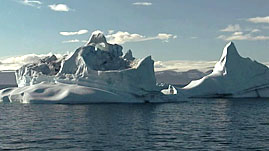Teachers' Domain - Digital Media for the Classroom and Professional Development
User: Preview

Source: National Film Board of Canada
In this video segment adapted from the National Film Board of Canada, learn about the Arctic's role in Earth's global climate system. Animations illustrate how ocean currents that circulate around the planet redistribute heat and moderate climate. Explore how the effects of global warming in the Arctic could have consequences throughout the world, through modification of thermohaline circulation, changes in Earth's overall albedo, and the release of carbon dioxide and methane from permafrost and the methane hydrate layer.
Earth's climate is maintained by the continuous cycling of energy through the planet's various systems. The oceans, air, land, and living things are all interconnected as a single integrated system. Because solar radiation strikes Earth's surface at varying angles from north to south, the planet is heated unevenly, and areas near the equator are heated more intensely than at the poles. The resulting temperature differences drive global circulation patterns as heat flows from warmer to cooler regions. In the atmosphere, warmer, less dense air rises as colder, denser air sinks, creating convection currents. The movement of air masses and Earth's rotation create air circulation cells and zones where winds blow in characteristic patterns. In the oceans, heat is redistributed around the planet via tides and ocean currents, which result from wind acting on the surface of the water and from density differences resulting from variations in temperature and salinity.
Ocean surface currents resemble global wind patterns; for instance, at mid-latitudes, both wind and ocean currents tend to blow from west to east. In the North Pacific Ocean, the North Pacific Current flows eastward until it splits into two circulation cells, or gyres: the California Current circulates down the coast of California to bring relatively cool water toward the equator and the Alaska Current circulates relatively warm water up the coast of Canada and Alaska. Thermohaline circulation, also known as the Great Ocean Conveyor belt, is a global circulation pattern that connects both surface and deep water currents. It results from differences in water temperature and density and is driven by the cold, salty water formed in the polar regions. Cold water is denser than warmer water, and the formation of sea ice leaves behind salt, further increasing the salinity and density of the water. The dense water sinks and flows along the ocean floor, driving thermohaline circulation.
In recent years, there have been noticeable changes in Earth's climate as average temperatures have increased. Climate change effects are particularly evident in the Arctic, where the snow- and ice-covered landscape is especially sensitive to change. For example, warmer temperatures have caused changes in the extent of snow and ice cover. While the effects of these changes have a direct impact on the people of the region (such as subsistence hunters who depend on the sea ice for hunting), changes in the Arctic might also create repercussions throughout the Earth system. For instance, a decrease in the formation of sea ice could modify thermohaline circulation as well as increase the amount of solar radiation that Earth's surface absorbs (because of the lower albedo of water compared to ice). This, in turn, could create a positive feedback loop that would exacerbate global warming. Scientists do not know the speed, size, and full effects of climate change, although most scientists agree that there will be profound effects on the planet.
 Loading Standards
Loading Standards Teachers' Domain is proud to be a Pathways portal to the National Science Digital Library.
Teachers' Domain is proud to be a Pathways portal to the National Science Digital Library.
